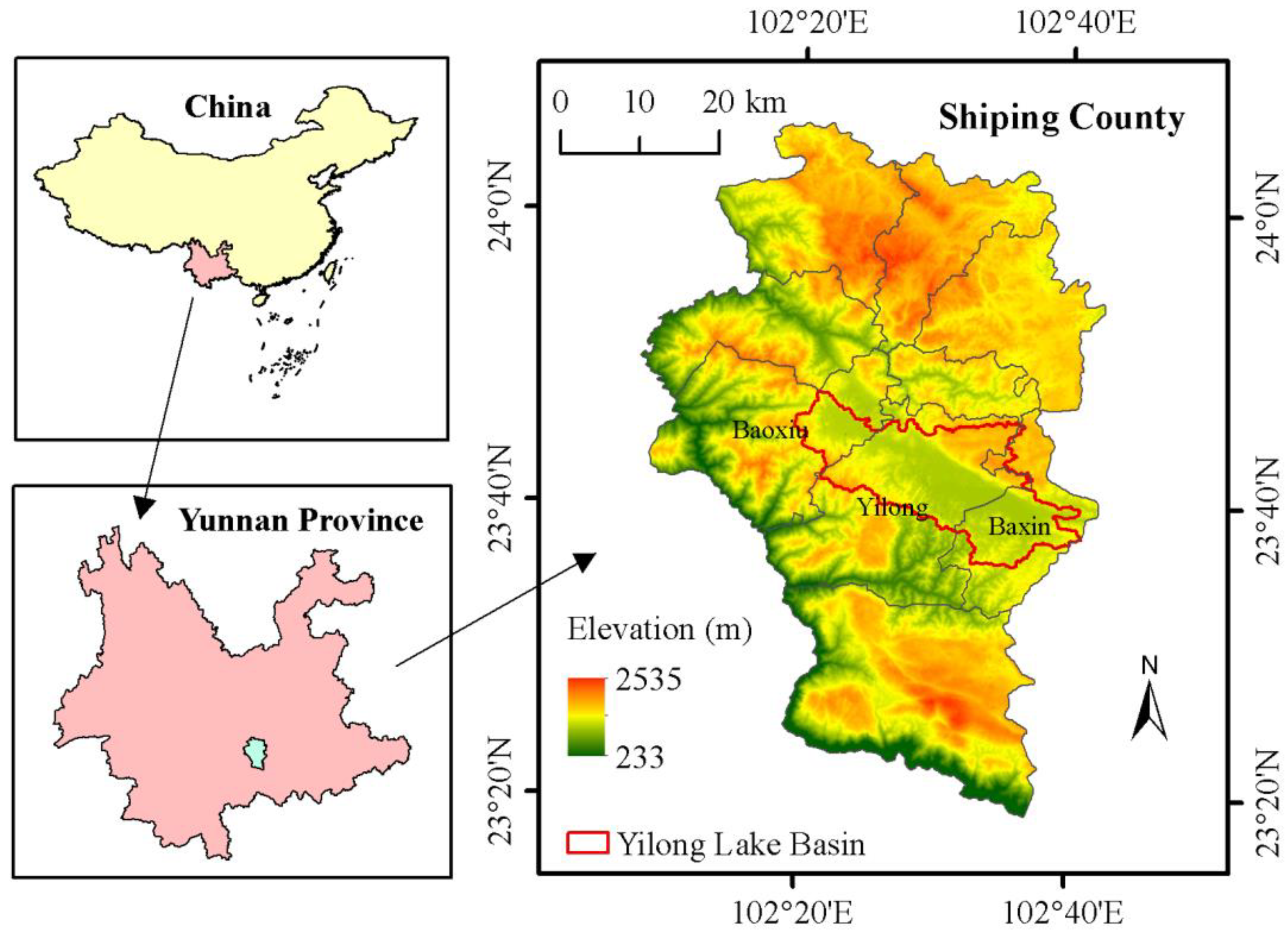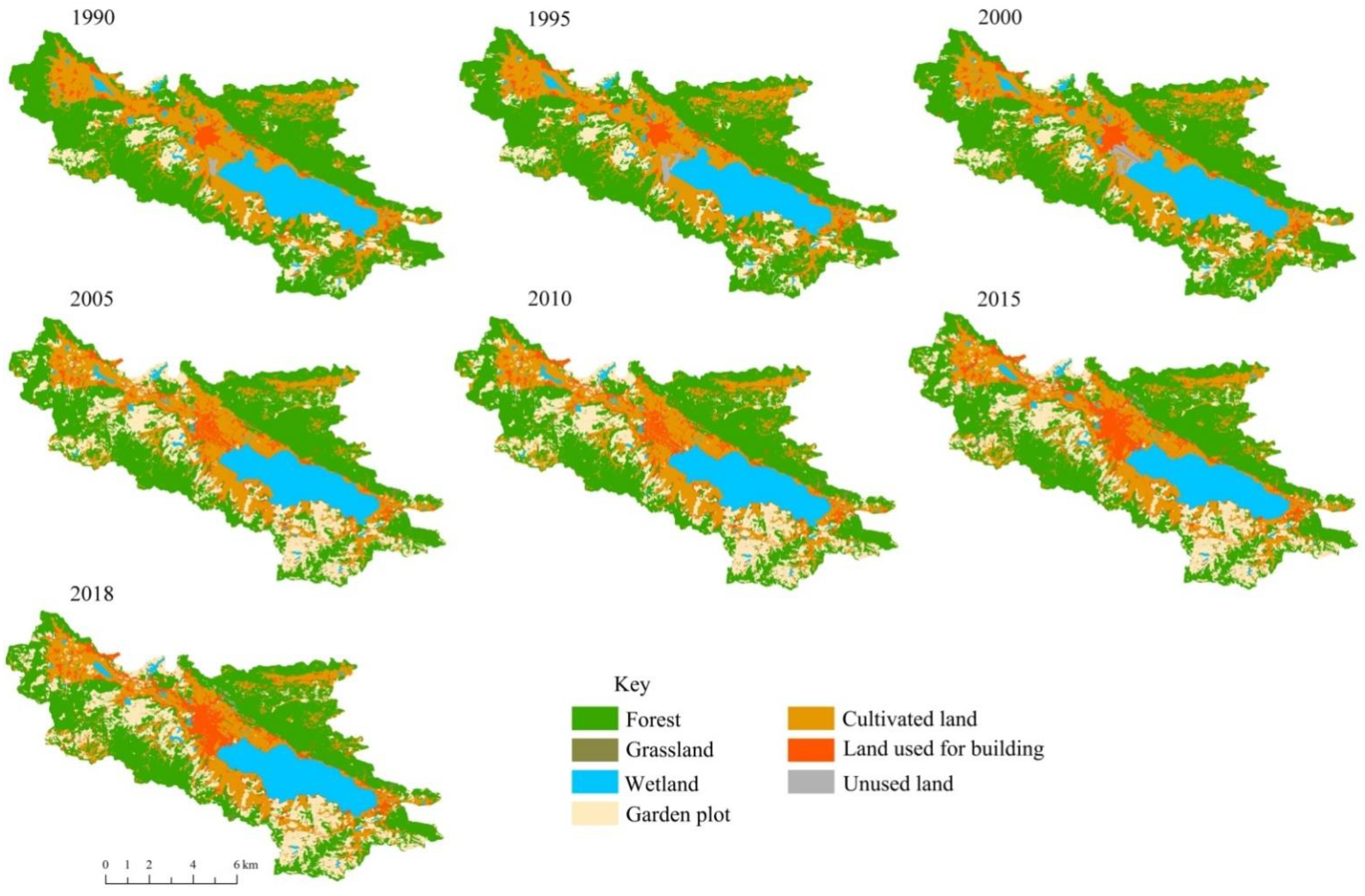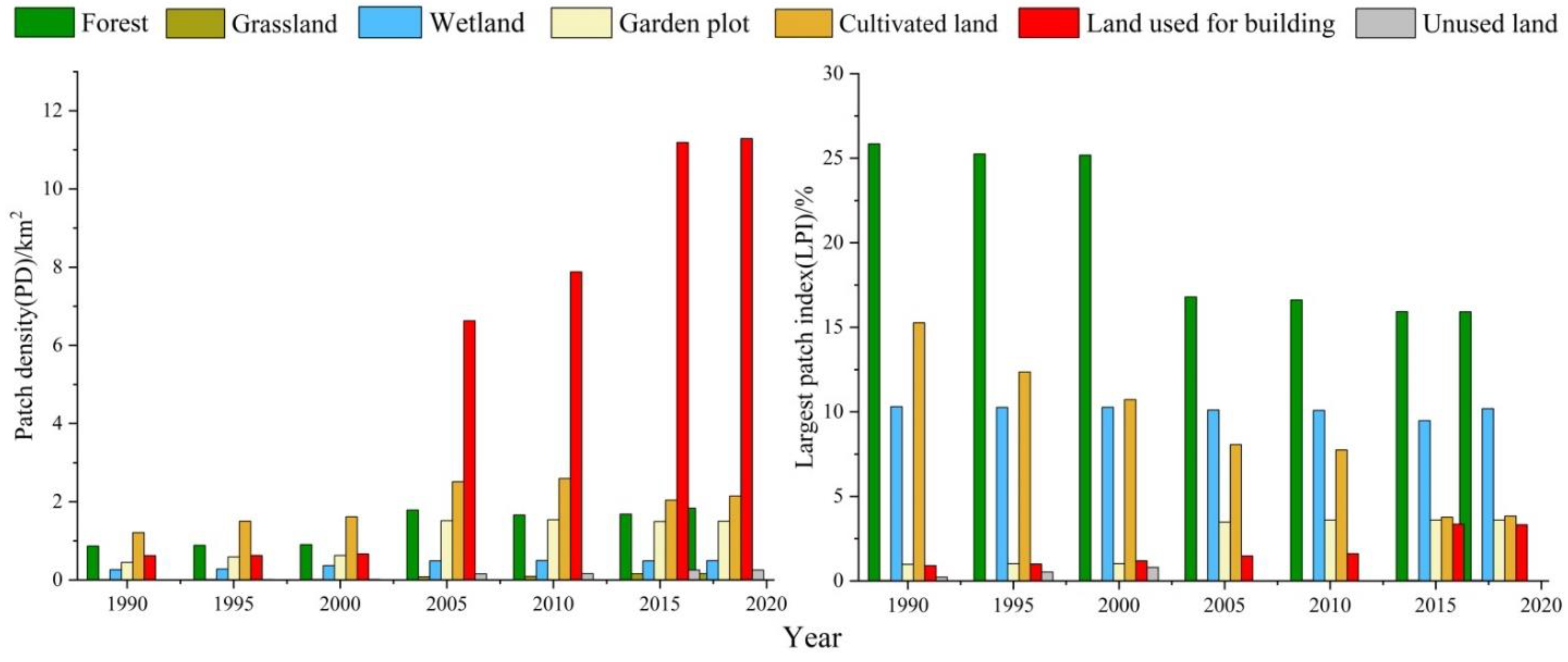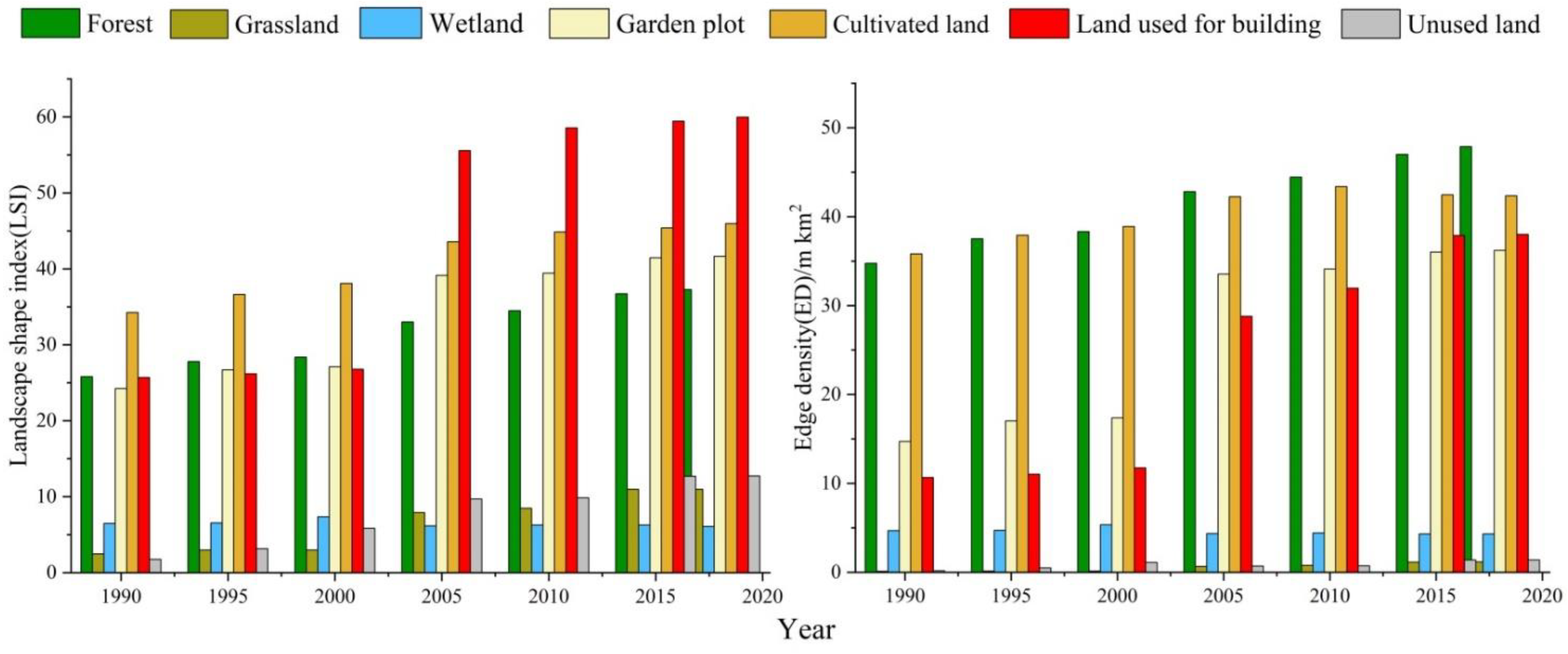Analysis of Landscape Pattern Evolution and Driving Forces Based on Land-Use Changes: A Case Study of Yilong Lake Watershed on Yunnan-Guizhou Plateau
Abstract
:1. Introduction
2. Materials and Methods
2.1. Study Area
2.2. Data Source and Processing
2.3. Method
2.3.1. Land-Use Change
- (1)
- Dynamic degree of land use; it refers to the quantitative change inland-use types within a certain time range in the study area, reflecting the impact of human activities on land-use types [26]. By quantitatively describing the change speed of land-use types, its development trend can be predicted. The expression of dynamic degree of land-use type is:where: K is the dynamic degree of a certain landscape type in a certain period of time; and are the area of a certain landscape type at the initial stage and the final stage of the study, hm2; T is the time, .
- (2)
- Land-use transfer matrix; it contains the static data of land-use types in a certain period of time and the dynamic data of mutual transformation of various land types. The transfer direction and quantity of different types of land use are analyzed through the transfer matrix, and the general form of land-use transfer matrix refers to the relevant literature [27]. This study uses the calculation method to analyze the internal transfer of land-use types in the study area.where S represents the area, n represents the number of land-use types before and after the transfer, i represents the land-use type before the transfer, and j represents the land-use type after the transfer, which is the area from land class i to land class j. Each row of elements in the matrix represents the local class source information of each local class before the transfer of land class j.
2.3.2. Landscape Index Analysis
2.3.3. Collection and Treatment of Human and Natural Factors
3. Results
3.1. Dynamic Change Characteristics of Land Use
3.2. Change in Landscape Pattern Index
3.3. Relationship between Watershed Landscape Change and Natural, Social and Economic Development
4. Discussion
4.1. Dynamic Change Analysis of Land Use
4.2. Driving Forces of Landscape Evolution and Suggestions
5. Conclusions
- (1)
- The land use of the Yilong Lake Basin is mainly forest, garden and cultivated land. From 1990 to 2018, the area of construction land continued to increase, and the construction land in the basin was mainly transferred from cultivated land and forests. The disturbance of human activities and the change in natural factors jointly affect the land-use type, spatial distribution and landscape diversity of the Yilong Lake Basin, but their contribution to the ecosystem of the basin is different. The explanation degree of human disturbance to wetland area and landscape diversity index is 80.97%, and the explanation degree of natural factor change is 13.90%. Economic growth, population growth, social affluence and agricultural development are the main socio-economic driving factors of land-use change in the Yilong Lake Basin, and the driving effects of driving factors on land-use change in the basin are increasing year by year. According to the correlation analysis, the driving effects of socio-economic driving factors on land-use change are different. Among them, economic growth, especially industrial structure adjustment, agricultural development and residents’ living standards, are the main driving forces affecting cultivated land and forests; population growth and residents’ living standards are the main driving forces of the waters. The main factors affecting construction land are population growth, agricultural development, and economic growth.
- (2)
- With the social and economic development, the land-use structure of the basin has been continuously optimized, and the degree of land-use intensification has gradually increased. The shape of landscape patches in the basin is complicated, and the landscape fragmentation and diversity are increased. Urban land and rural residential areas show continuous growth, whereas cultivated land shows a trend of fragmentation. The leap-forward growth of urban land is the main cause of the complexity of the shape of watershed landscape patches. With the ecological restoration of the Yilong Lake Basin, the implementation of the ecological protection and governance of the Yilong Lake surface mountain, the return of the pond to the lake and the ecological restoration, the replenishment and water supply of Yilong Lake and other governance projects, the study on the change in the landscape pattern index shows that the number and density of patches are decreasing as a whole, which means that the landscape fragmentation is smaller, making the landscape types richer, indicating that the important landscape types in the Yilong Lake Basin are protected, and the ecological environment is gradually improving. Therefore, reducing the excessive impact of human activities on the watershed ecosystem is the key to realize the ecological protection of the Yilong Lake Basin.
Author Contributions
Funding
Institutional Review Board Statement
Informed Consent Statement
Data Availability Statement
Acknowledgments
Conflicts of Interest
References
- Shen, G.; Xu, B.; Jin, Y.X.; Chen, S.; Zhang, W.B.; Guo, J.; Liu, H.; Zhang, Y.J.; Yang, X.C. Research progress of Ruoergai Plateau Wetland. Geogr. Geogr. Inf. Sci. 2016, 32, 76–82. [Google Scholar]
- Yang, L.; Li, H. Editor in Chief Yunnan Wetland; China Forestry Press: Beijing, China, 2009; pp. 94–100. [Google Scholar]
- Li, S.L. Comprehensive management of ecological environment in Yilong Lake Watershed. For. Investig. Plan. 2009, 34, 108–111. [Google Scholar]
- She, L.H.; Liu, P.C.; Zhang, F.Q.; Cai, F. Current situation and Protection Countermeasures of Yilong Lake Wetland in Yunnan. For. Constr. 2016, 15–18. (In Chinese) [Google Scholar]
- Song, S.B.; Zeng, B.; Zhou, T.G.; Guan, S. Dynamic analysis of wetland landscape in Wujiang River Watershed (Chongqing Section) based on RS and GIS. China Soil Water Conserv. Sci. 2017, 15, 81–88. [Google Scholar]
- Zhaoxu, Y.Z.; Liu, L.P. Assessment method of water environment in wetland reserve and its application. Surv. Sci. Technol. 2008, 3, 30–32. [Google Scholar]
- Zorrilla-Miras, P.; Palomo, I.; Gómez-Baggethun, E.; Martín-López, B.; Lomas, P.L.; Montes, C. Effects of land-use change on wetland ecosystem services: A case study in the Doñana marshes (SW Spain). Landsc. Urban Plan. 2014, 122, 160–174. [Google Scholar] [CrossRef]
- Lin, W.P.; Gen, J.W.; Xu, D.; Du, S.; Gao, J. Wetland landscape pattern changes over a period of rapid development (1985–2015) in the Zhoushan Islands of Zhejiang province, China. Estuar. Coast. Shelf Sci. 2018, 213, 148–159. [Google Scholar] [CrossRef]
- Aduah, M.S.; Jewitt, G.P.W.; Toucher, M.L.W. Assessing impacts of land use changes on the hydrology of a lowland rainforest catchment in ghana, West Africa. Water 2018, 10, 9. [Google Scholar] [CrossRef] [Green Version]
- Wang, G.X.; Shen, Y.P.; Cheng, G.D. Analysis on the changes and causes of ecological environment in the source area of the Yellow River. Glacial Permafr. 2000, 22, 200–205. [Google Scholar]
- Chen, Z.K.; Lu, X.G. Comparative study on the landscape pattern of swamp wetland in Ruoergai Plateau in two periods. Wetl. Sci. 2010, 8, 8–14. [Google Scholar]
- Perring, M.P.; De Frenne, P.; Baeten, L.; Maes, S.L.; Depauw, L.; Blondeel, H.; Carón, M.M.; Verheyen, K. Global environmental change effects on ecosystems: The importance of land-use legacies. Glob. Chang. Biol. 2016, 22, 1361–1371. [Google Scholar] [CrossRef] [PubMed]
- Gueneralp, B.; Seto, K.C.; Ramachandran, M. Evidence of urban land teleconnections and impacts on hinterlands. Curr. Opin. Environ. Sustain. 2013, 5, 445–451. [Google Scholar] [CrossRef]
- Zhang, J.T.; Qiu, Y.; Zheng, F.Y. Quantitative research method of landscape pattern. J. Mt. Reg. 2000, 18, 346–352. [Google Scholar]
- Xu, X.L.; Wang, X.J.; Zhu, X.P.; Jia, H.T.; Han, D.L. Analysis on landscape pattern evolution of Swan Lake alpine wetland in Bayinbuluke from 1996 to 2015. J. Nat. Resour. 2018, 33, 1897–1911. [Google Scholar]
- Zhao, W.W.; Fang, X.N. Landscape sustainability and landscape sustainability science. J. Ecol. 2014, 34, 2453–2459. [Google Scholar]
- Erwin, K.L. Wetlands and global climate change: The role of wetland restoration in a changing world. Wetl. Ecol. Manag. 2009, 17, 71–84. [Google Scholar] [CrossRef]
- Xie, Z.L.; Xu, X.G.; Yan, L. Analyzing qualitative and quantitative changes in coastal wetland associated to the effects of natural and anthropogenic factors in a part of Tianjin, China. Estuar. Coast. Shelf Sci. 2010, 86, 379–386. [Google Scholar] [CrossRef]
- Hong, J.; Lu, X.N.; Wang, L.L. Driving forces of wetland landscape evolution in the Yellow River Delta from 1973 to 2013. J. Ecol. 2016, 36, 924–935. [Google Scholar]
- Ren, L.L.; Li, Y.Z.; Yu, M.; Yang, J.S.; Zhan, C.; Zhou, D. Evolution and main driving factors of constructed wetlands in the Yellow River Delta from 1984 to 2015. J. Agric. Resour. Environ. 2020, 37, 493–502. [Google Scholar]
- Zhou, Z.L.; Sha, J.M.; Fan, Y.X.; Shuai, C.; Gao, S. Analysis on spatial-temporal changes and driving forces of impervious surface landscape pattern in Xiamen City. J. Appl. Ecol. 2020, 31, 230–238. [Google Scholar]
- Wu, L.N.; Yang, S.T.; Liu, X.Y.; Luo, Y.; Zhou, X.; Zhao, H.G. Response of land use change to human activities in Beiluo River Watershed since 1976. J. Geogr. 2014, 69, 54–63. [Google Scholar]
- Zhao, X.Q.; Li, S.N.; Pu, J.W.; Miao, P.P.; Wang, Q.; Tan, K. Optimization of the national land space based on the coordination ofurban-agricultural-ecological functions in the Karst Areas of Southwest China. Sustainability 2019, 11, 6752. [Google Scholar] [CrossRef] [Green Version]
- Shi, Z.; Deng, W.; Zhang, S. Spatio-temporal pattern changes of land space in Hengduan Mountains during 1990–2015. J. Geogr. Sci. 2018, 28, 529–542. [Google Scholar] [CrossRef] [Green Version]
- Kates, R.; Clark, W.; Corell, R.; Hall, J.; Jaeger, C.; Lowe, I.; McCarthy, J.; Schellnhuber, H.; Bolin, B.; Dickson, N.; et al. Environmentand development. Sustainability science. Science 2001, 292, 641–642. [Google Scholar] [CrossRef] [PubMed]
- Gb/t21010-2017; Classification of Land Use Status. China Land and Resources Standardization Technical Committee: Beijing, China, 2017.
- Lv, L.T.; Zhang, J.; Peng, Q.Z.; Ren, F.P.; Jiang, Y. Analysis and prediction of landscape pattern evolution in Dongjiang River Watershed. J. Ecol. 2019, 39, 6850–6859. [Google Scholar]
- Qin, F.; Fukamachi, K.; Shibata, S. Land-Use/Landscape Pattern Changes and Related Environmental Driving Forces in a Dong Ethnic Minority Village in Southwestern China. Land 2022, 11, 349. [Google Scholar] [CrossRef]
- Bu, R.C.; Hu, Y.M.; Chang, Y.; Li, X.Z.; He, H.S. Correlation analysis between landscape indexes. J. Ecol. 2005, 2764–2775. [Google Scholar]
- Wu, J.G. Landscape Ecology—Pattern, Process, Scale and Grade, 2nd ed.; Higher Education Press: Beijing, China, 2012; pp. 106–115. [Google Scholar]
- Xu, J.R.; Dong, J.H. Study on landscape pattern change and its driving forces of Nansihu wetland from 1987 to 2010. Wetl. Sci. 2013, 11, 438–445. [Google Scholar]
- Wang, H.; Zhang, M.; Wang, C.; Wang, K.; Wang, C.; Li, Y.; Bai, X.; Zhou, Y. Spatial and Temporal Changes of Landscape Patterns and Their Effects on Ecosystem Services in the Huaihe River Watershed, China. Land 2022, 11, 513. [Google Scholar] [CrossRef]
- Chen, G.X. Simulation of Land Use Change Based on Cloud-S Model and GIS; Nanjing University: Nanjing, China, 2012. [Google Scholar]
- Li, X.J. Development status and Countermeasures of Yilong lake fishery industry in Shiping County. Mod. Agric. Sci. Technol. 2014, 3, 328–329. (In Chinese) [Google Scholar]
- Ursu, A.; Stoleriu, C.C.; Ion, C.; Jitariu, V.; Enea, A. Romanian natura 2000 network: Evaluation of the threats and pressures through the corine Land cover dataset. Remote Sens. 2020, 12, 2075. [Google Scholar] [CrossRef]
- Song, X.P.; Hansen, M.C.; Stehman, S.V.; Potapov, P.V.; Tyukavina, A.; Vermote, E.F.; Townshend, J.R. Global land change from 1982 to 2016. Nature 2018, 560, 639–643. [Google Scholar] [CrossRef] [PubMed]
- Wei, F.; Han, G.X.; Zhang, J.P. Evolution of coastal wetlands under the influence of sea reclamation in Bohai Rim during 1985–2015. Chin. J. Ecol. 2018, 37, 1527–1537. [Google Scholar]
- Ke, C.Q.; Zhang, D.; Wang, F.Q.; Chen, S.X.; Schmullius, C.; Boerner, W.M.; Wang, H. Analyzing coastal wetland change in the Yancheng National Nature Reserve, China. Reg. Environ. Chang. 2011, 11, 161–173. [Google Scholar] [CrossRef]
- Ai, J.; Yang, L.; Liu, Y.; Yu, K.; Liu, J. Dynamic Landscape Fragmentation and the Driving Forces on Haitan Island, China. Land 2022, 11, 136. [Google Scholar] [CrossRef]
- Zhang, M.; Gong, Z.N.; Zhao, W.J. A duo Landscape pattern change and driving mechanism of Baiyangdian Wetland in recent 30 years. J. Ecol. 2016, 36, 4780–4791. [Google Scholar]
- Wu, J.S.; Wang, Z.; Zhang, L.Q.; Song, J. Research Progress on driving forces of landscape pattern change. Prog. Geogr. Sci. 2012, 31, 1739–1746. [Google Scholar]
- Yang, M.; Gong, J.G.; Zhao, Y.; Wang, H.; Zhao, C.P. Dynamic change and trend analysis of Baiyangdian regional landscape pattern. J. Ecol. 2020, 40, 7165–7174. [Google Scholar]
- Wang, W.J.; Zhao, X.Y.; Wan, W.Y.; Li, H.; Xue, B. Vegetation coverage change and its response to climate change in Gannan plateau from 2000 to 2014. J. Ecol. 2016, 35, 2494–2504. [Google Scholar]
- Zhang, M.; Zeng, Y.N. Temporal and spatial dynamic changes and driving forces analysis of wetland landscape of Chang-Zhu-Tan urban agglomeration. Trans. Chin. Soc. Agric. Eng. 2018, 34, 241–249. [Google Scholar]




| Main Categories | Secondary Category | Corresponding Land-Use Types |
|---|---|---|
| Ecological space | Forest | Bamboo forest land, arbor forest land, shrub land and other forest lands |
| Grassland Wetland | grassland | |
| Lakes, river wetlands, swamp wetlands, artificial wetlands | ||
| Production space | Garden plot | Garden plot |
| Cultivated land | Paddy field, dry land | |
| Living space | Land used for building | Construction land for urban and rural residents, industrial and mining construction land, and transportation land |
| Unused land | Bare ground |
| Year | Index | Forest | Grassland | Wetland | Garden Plot | Cultivated Land | Land Used for Building | Unused Land |
|---|---|---|---|---|---|---|---|---|
| 1990 | Area/km2 | 181.66 | 41.79 | 0.15 | 30.02 | 89.34 | 13.84 | 0.83 |
| 1995 | 178.84 | 41.62 | 0.25 | 33.28 | 87.41 | 14.27 | 1.95 | |
| 2000 | 178.32 | 42.06 | 0.25 | 33.53 | 85.01 | 15.53 | 2.9 | |
| 2005 | 157.76 | 40.04 | 0.58 | 60.75 | 76.49 | 21.56 | 0.41 | |
| 2010 | 154.06 | 39.91 | 0.7 | 62.08 | 76.38 | 24.04 | 0.43 | |
| 2015 | 151.28 | 37.96 | 0.91 | 62.56 | 71.22 | 32.72 | 0.94 | |
| 2018 | 151.21 | 40.42 | 0.93 | 62.54 | 69.17 | 32.4 | 0.94 | |
| 1990–1995 | Area/km2 | −2.82 | −0.17 | 0.1 | 3.26 | −1.93 | 0.43 | 1.12 |
| Dynamic degree/% | −0.31 | −0.08 | 13.33 | 2.17 | −0.43 | 0.62 | 26.99 | |
| 1995–2000 | Area/km2 | −0.52 | 0.44 | 0 | 0.25 | −2.4 | 1.26 | 0.95 |
| Dynamic degree/% | −0.06 | 0.21 | 0.00 | 0.15 | −0.55 | 1.77 | 9.74 | |
| 2000–2005 | Area/km2 | −20.56 | −2.02 | 0.33 | 27.22 | −8.52 | 6.03 | −2.49 |
| Dynamic degree/% | −2.31 | −0.96 | 26.40 | 16.24 | −2.00 | 7.77 | −17.17 | |
| 2005–2010 | Area/km2 | −3.7 | −0.13 | 0.12 | 1.33 | −0.11 | 2.48 | 0.02 |
| Dynamic degree/% | −0.47 | −0.06 | 4.14 | 0.44 | −0.03 | 2.30 | 0.98 | |
| 2010–2015 | Area/km2 | −2.78 | −1.95 | 0.21 | 0.48 | −5.16 | 8.68 | 0.51 |
| Dynamic degree/% | −0.36 | −0.98 | 6.00 | 0.15 | −1.35 | 7.22 | 23.72 | |
| 2015–2018 | Area/km2 | −0.07 | 2.46 | 0.02 | −0.02 | −2.05 | −0.32 | 0 |
| Dynamic degree/% | −0.02 | 2.16 | 0.73 | −0.01 | −0.96 | −0.33 | 0.00 | |
| 1990–2018 | Area/km2 | −30.45 | −1.37 | 0.78 | 32.52 | −20.17 | 18.56 | 0.11 |
| Dynamic degree/% | −0.60 | −0.12 | 18.57 | 3.87 | −0.81 | 4.79 | 0.47 |
| 1990–2018 | Forest | Grassland | Wetland | Garden Plot | Cultivated Land | Land Used for Building | Unused Land | Total |
|---|---|---|---|---|---|---|---|---|
| Forest | 0.11 | 0.00 | 0.01 | 0.02 | 0.14 | |||
| Grassland | 0.01 | 57.00 | 13.42 | 6.98 | 1.64 | 0.18 | 10.11 | 89.34 |
| Wetland | 0.01 | 1.05 | 11.55 | 0.75 | 0.01 | 0.11 | 0.37 | 13.86 |
| Garden plot | 0.77 | 6.39 | 4.81 | 140.25 | 0.11 | 0.53 | 28.84 | 181.69 |
| Cultivated land | 0.01 | 2.19 | 0.63 | 0.12 | 38.57 | 0.09 | 0.16 | 41.77 |
| Land used for building | 0.02 | 0.78 | 0.02 | 0.83 | ||||
| Unused land | 0.03 | 2.45 | 1.27 | 3.09 | 0.11 | 0.03 | 23.00 | 29.97 |
| Total | 0.93 | 69.11 | 32.47 | 151.21 | 40.43 | 0.94 | 62.52 | 357.61 |
| Year | PD (/km2) | LPI (%) | LSI | ED | CONTAG (%) | SHDI |
|---|---|---|---|---|---|---|
| 1990 | 3.4227 | 25.85 | 26.1209 | 50.4526 | 58.2824 | 1.2925 |
| 1995 | 3.8953 | 25.2454 | 27.9968 | 54.4215 | 56.9152 | 1.3242 |
| 2000 | 4.1945 | 25.183 | 28.9619 | 56.4634 | 56.1037 | 1.3426 |
| 2005 | 13.1652 | 16.79 | 38.4485 | 76.5342 | 51.46 | 1.4248 |
| 2010 | 14.4124 | 16.6096 | 40.0508 | 79.9242 | 50.5428 | 1.4431 |
| 2015 | 17.2996 | 15.9195 | 42.5397 | 85.0927 | 48.867 | 1.478 |
| 2018 | 17.6757 | 15.9127 | 42.755 | 85.6456 | 48.7175 | 1.4818 |
| Drivers | Landscape Index | |||||
|---|---|---|---|---|---|---|
| PD | LPI | LSI | ED | CONTAG | SHDI | |
| TP | 0.963 ** | −0.923 ** | 0.970 ** | 0.970 ** | −0.980 ** | 0.984 ** |
| RP | −0.238 | 0.091 | −0.186 | −0.186 | 0.211 | −0.224 |
| UP | 0.784 * | −0.670 | 0.757 * | 0.758 * | −0.779 * | 0.789 * |
| T | 0.935 ** | −0.908 ** | 0.937 ** | 0.937 ** | −0.935 ** | 0.934 ** |
| P | −0.143 | 0.235 | −0.184 | −0.185 | 0.170 | −0.162 |
| PI | 0.883 ** | −0.789 * | 0.866 * | 0.867 * | −0.884 ** | 0.891 ** |
| SI | 0.780 * | −0.669 | 0.752 | 0.752 | −0.771 * | 0.779 * |
| TI | 0.795 * | −0.683 | 0.767 * | 0.768 * | −0.786 * | 0.795 * |
| AF | 0.907 ** | −0.819 * | 0.888 ** | 0.888 ** | −0.900 ** | 0.905 ** |
| F | 0.922 ** | −0.843 * | 0.901 ** | 0.901 ** | −0.911 ** | 0.914 ** |
| TC | 0.961 ** | −0.917 ** | 0.966 ** | 0.966 ** | −0.976 ** | 0.980 ** |
| LLB | 0.820 * | −0.723 | 0.802 * | 0.803 * | −0.819 * | 0.826 * |
| PB | 0.754 | −0.696 | 0.750 | 0.751 | −0.757 * | 0.758 * |
Publisher’s Note: MDPI stays neutral with regard to jurisdictional claims in published maps and institutional affiliations. |
© 2022 by the authors. Licensee MDPI, Basel, Switzerland. This article is an open access article distributed under the terms and conditions of the Creative Commons Attribution (CC BY) license (https://creativecommons.org/licenses/by/4.0/).
Share and Cite
Ma, G.; Li, Q.; Yang, S.; Zhang, R.; Zhang, L.; Xiao, J.; Sun, G. Analysis of Landscape Pattern Evolution and Driving Forces Based on Land-Use Changes: A Case Study of Yilong Lake Watershed on Yunnan-Guizhou Plateau. Land 2022, 11, 1276. https://doi.org/10.3390/land11081276
Ma G, Li Q, Yang S, Zhang R, Zhang L, Xiao J, Sun G. Analysis of Landscape Pattern Evolution and Driving Forces Based on Land-Use Changes: A Case Study of Yilong Lake Watershed on Yunnan-Guizhou Plateau. Land. 2022; 11(8):1276. https://doi.org/10.3390/land11081276
Chicago/Turabian StyleMa, Guoqiang, Qiujie Li, Shuyu Yang, Rong Zhang, Lixun Zhang, Jianping Xiao, and Guojun Sun. 2022. "Analysis of Landscape Pattern Evolution and Driving Forces Based on Land-Use Changes: A Case Study of Yilong Lake Watershed on Yunnan-Guizhou Plateau" Land 11, no. 8: 1276. https://doi.org/10.3390/land11081276
APA StyleMa, G., Li, Q., Yang, S., Zhang, R., Zhang, L., Xiao, J., & Sun, G. (2022). Analysis of Landscape Pattern Evolution and Driving Forces Based on Land-Use Changes: A Case Study of Yilong Lake Watershed on Yunnan-Guizhou Plateau. Land, 11(8), 1276. https://doi.org/10.3390/land11081276






